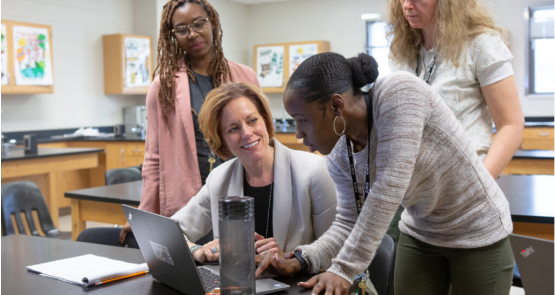2. Critical Reading: Developing Critical Thinking Through Reading
When people think of high-level reasoning skills, they don’t often think if being a critical reading. Instead, they think of mathematicians and scientists, who are seen as drawing strict conclusions that follow logically from dry analysis of statistical evidence.
To be sure, mechanical, purely logical thought is a vital part of reasoning and critical thinking. But it is not everything. Critical thinking involves skills in interpretation in contexts that are multi-layered and ambiguous.
Close and critical reading is one of the best ways for students to develop skills in this kind of interpretation. As teachers think about developing critical thinking through literature they should focus on interpretive skills. Through their discussions, reflections, and reading and writing on fiction and literature, students ideally learn to develop critical thinking skills like the following:
- how to empathize with multiple perspectives;
- how to interrogate and interpret the author’s perspective;
- how to ask and engage with complex moral and philosophical questions;
- how to recognize and reckon with ambiguity.
This kind of reflection can start young — younger than we might ordinarily think. There’s a lot teachers can do to develop skills in critical thinking and reading.

Critical Reading Through Open-Ended Discussion
To facilitate growth in critical reading, teachers can build in time for open-ended discussion and resist the urge to steer students toward “correct” answers.
A good literary text is rarely able to be captured by a single interpretation. It is, of course, important to ensure students are progressing in basic comprehension skills and reading at grade level.
But when it comes to critical reading — delving into the meaning of a particular text — teachers should be open to students’ initial reflections and encourage them to express and develop their views no matter how rudimentary they might be at first.
Before engaging in more well-defined exercises and discussion, therefore, instructors can give students practice with more open-ended reflection. This will help them gain comfort and experience articulating their immediate reactions and beginning to question texts in a more structured way.
Many teachers will begin a discussion of a text with a set of questions like:
- What’s the author’s point of view or argument?
- What’s the intended audience?
- What’s the author’s purpose?
- How do they use rhetorical devices or figurative language?
This kind of questioning is, of course, important, but it can be more powerful and worthwhile to students if it comes organically out of their immediate reactions, rather than being experienced as something imposed from the outside. Otherwise, these can seem like simple questions with right or wrong answers that preclude deeper critical engagement, instead of starting points for that engagement.
For example, if a teacher wants to talk about rhetorical devices, they might begin by asking students more simply:
- What jumped out at them in the reading?
- What did it make them feel?
- What do you think produced that feeling?
A teacher can move from there to the devices that might be at work producing that effect.
Similarly, before initiating a conversation about point of view, teachers might ask:
- Did you feel able to identify with the author?
- What questions did the passage raise about the author’s identity and perspective?
Eventually, if this is well-modeled and scaffolded, the practice of interrogating point of view or rhetoric will become natural to students. They will practice critical reading organically, instead of a kind of algorithm that they are meant to apply to the text.

Critical Reading and Interpretation
Just because a text is open to interpretation doesn’t mean that there are not better and worse interpretations to offer or questions to raise. But a good interpretation cannot be measured by simply applying a preconceived standard. It shows its value in the manner in which it is backed up by evidence from the text and convincing argument.
A combination of written and spoken exercises can be useful here. Sometimes it can lead to improved contributions if students think over their views while writing before convening in small or large groups to discuss the issue. In particular, writing can help with what’s called metacognition, or thinking about thinking. Being forced to write down their views can help students step back and think about why they think what they think.
Engagement with the text should serve to broaden students’ horizons and get them to examine their own thinking and beliefs. Students have to, to a certain extent, drive this process. But teachers must facilitate discussion and exploration, and make sure it doesn’t go off the rails.
This takes skill and experience, of course, as well as confidence. Teachers must be willing to let the reins go a little bit and see where the conversation takes students. They must also be adept at facilitating: resisting the urge to intervene too forcefully or reinterpret students’ comments and, instead, encouraging other students to enter the conversation and begin responding to each other.
Finally, developing critical thinking through reading involves fostering an ability to draw connections between disparate fields. This means examining the significance of texts for one’s own experience and for broader issues in history and everyday life.
When students learn to do this, they extend some of the habits of thinking they learn through the study of literature into their daily lives. The goal is more reflective thoughtful people, who develop problem-solving skills, make better decisions and, ultimately, live more meaningful lives.

An Example of a Discussion Around Fantastic Mr. Fox
What follows is an example of a critical thinking oriented discussion and close reading exercise around Roald Dahl’s Fantastic Mr. Fox. It’s geared toward younger grades, but teachers of all levels may find ideas for how to build discussion around appropriate texts.
Toward the middle of Dahl’s story, Mr. Fox is hiding out in his foxhole with his family from three farmers (Boggis, Bunce, and Bean), who wait with guns outside the hole, attempting to starve the Foxes out.
Mr. Fox comes up with a plan to outlast them. Along with his children, he digs into the farmers’ storehouses from underneath and steals food so his family can survive. As he’s in the process of stealing he meets up with Badger, who has reservations about stealing.
Remember, again, that students shouldn’t be pushed toward any right answers, but instead prompted to dig deeper. As researcher Judith Langer puts it, when it comes to critical thinking and literature, “musing itself is the goal.”

Text from Fantastic Mr. Fox
Suddenly Badger said, “Doesn’t this worry you just a tiny bit, Foxy?”
“Worry me?” said Mr Fox. “What?”
“All this… this stealing.”
Mr. Fox stopped digging and stared at Badger as though he had gone completely dotty. “My dear old furry friend, he said, “Do you know anyone in the whole world who can refuse to steal a few chickens if his children are starving to death?”
There was a short silence while Badger thought deeply about this.
“You are far too respectable,” said Mr. Fox.
“There’s nothing wrong with being respectable,” Badger said.
“Look,” said Mr. Fox, “Boggis and Bunce and Ben are out to kill us. You realize that, I hope?”
“I do, Foxy, I do indeed,” said the gentle Badger.
“But we’re not going to be like them. We don’t want to kill them.”
“I hope not,” said Badger.
“We shall never do it,” said Mr. Fox. “We shall simply take a little food here and there to keep us and our families alive. Right?”
“I think we’ll have to,” said Badger.
Opening Discussion
After soliciting students immediate reactions, teachers might proceed by introducing more structured questions like:
- How does Mr. Fox justify stealing? Does his justification seem right to you? Why?
Many students will find Mr. Fox’s justification perfectly sound. Educators can push the conversation forward, though, by making sure that they’re giving reasons they believe his justification, however. The teacher can also complicate things by introducing new questions like the following:
- Was Mr. Fox’s stealing justified in the beginning of the book before Boggis, Bunce, and Bean attacked his foxhole? If not, what conditions would make the stealing unjustified?
Consider Perspectives
The next stage is to begin broadening perspective, and pushing students to consider more general and abstract questions:
- Why does Badger have reservations? What do you think “being respectable” means to Badger? What does it mean to Mr. Fox?
- What about the perspectives of the farmers? Should we have any sympathy for them in this situation?
Teachers can also ask students to consider their own experiences and perspectives, as well as those of their classmates.
- Have you ever been in a situation where you felt doing something that is ordinarily wrong was justified? What made it right or wrong?
Deepen
Finally, teachers can use the discussion of texts like Fantastic Mr. Fox as a launch point for more abstract discussions:
- Is being “respectable” always right? When might it not be?
- What does it mean that a moral rule (like “you shouldn’t steal”) seems like it can be broken for special circumstances?
- Should we live according to principles or based on the particular context we face? Is there such a thing as being “too principled”?
Sources and Resources
Beach, R., Appleman, D., Fecho, B., & Simon, R. (2016). Teaching literature to adolescents. Routledge.
Focuses on inquiry-based approach to literature and uses authentic case studies. Also discusses Common Core Standards.
Gruber, S., & Boreen, J. (2003). Teaching critical thinking: Using experience to promote learning in middle school and college students. Teachers and teaching, 9(1), 5-19.
Discussion of possibilities of using literature to reflection on students’ own experience, draws on philosopher John Dewey’s theory of experience.
Langer, J. A. (1992). Critical thinking and English language arts instruction. Albany: National Research Center on English Learning and Achievement.
Discusses aspects of critical thinking unique to ELA (as opposed to a generic conception of critical thinking).
Martinez, M. G., Yokota, J., & Temple, C. (2017). Thinking and Learning Through Children’s Literature. Rowman & Littlefield.
Overview of approaches to children’s learning with focus on making meaning; also includes research reviews and ideas for interdisciplinary instruction.



